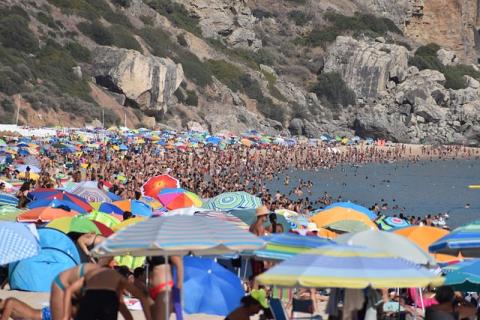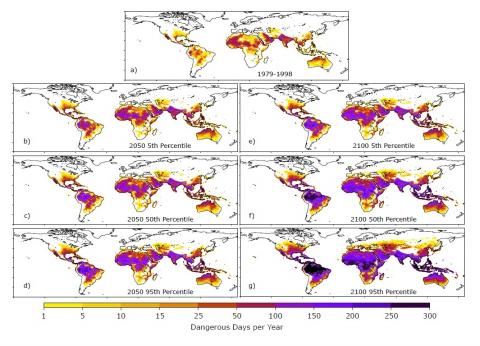Back to the headline of this article: is a heatwave in health the same as a heatwave in meteorology? The answer is that they do not normally coincide.
Currently, in Spain, the state administration has two systems of population information on the risk posed by extremely high temperatures.
The first of these, by historical tradition the oldest, is the information provided by the State Meteorological Agency (AEMET) on exceedances of the maximum daily temperature that occur above the 95th percentile of the historical series of maximum temperatures in the summer months, i.e. the definition of a heat wave in meteorology: "A 'heat wave' is considered to be an episode of at least three consecutive days, in which at least 10 % of the stations considered record maximums above the 95th percentile of their daily maximum temperature series for the months of July and August of the period 1971-2000." This is therefore a definition based solely on the climatology of each location.
On the other hand, heat waves in health are determined through epidemiological studies and refer to the maximum daily temperature above which daily mortality increases in a statistically significant way during a period of three days. This maximum daily temperature corresponds to a percentile in the series of maximum temperatures in the summer months (June to September), which sometimes coincides with the 95th percentile and sometimes does not.
Therefore, these are different pieces of information that correspond to different concepts: the first system is climatological and the second refers to a health indicator, such as mortality, which is influenced by the socio-economic, demographic and health characteristics of each place.
How are they defined?
Determining the 95th percentile of a temperature series is something that can be calculated immediately with a statistical programme. However, defining the heat wave temperature in health is a more complex process, as it depends on factors associated with the population and the socio-demographic structure of each area. In other words, it is necessary to ask whether the population is young or old, whether it has a good health care system, whether it is rural or urban, and whether its level of physiological adaptation to heat or its mechanisms to cope with high temperatures depend on its economic level. It does not, therefore, correspond to a fixed temperature percentile, but varies according to the population characteristics that are reflected in the mortality of each population analysed.
One system is climatological and the other refers to mortality, which depends on the socio-economic, demographic and health characteristics of each population
The Spanish Ministry of Health, with the scientific-technical support of the Carlos III Health Institute, determines these temperatures for each province, which serve as the basis for the "National Plan of Preventive Actions on the Effects of Excess Temperatures on Health", which has been activated every summer since 2004. The percentiles to which the heatwave definition temperatures correspond in health range from the 82nd percentile in Palencia to the 98th percentile in Badajoz, for example.
The Autonomous Communities can also generate their own alerts and prevention plans for extreme temperatures, as competences in health and public health have been transferred to them. In some cases, the Ministry of Health thresholds are used.
Confusing for the population
The two definitions, therefore, correspond to different realities and the experts on this issue are clear about this, but not the population. The Spanish Ministry of Health issues its own health alerts based on its heatwave definition threshold temperatures. It does so through its website and social networks, and with an SMS alert notification campaign for registered users of the service. However, the information that reaches the public on a massive scale is that which is broadcast on radio and television, which is mostly provided by AEMET.
The Ministry of Labour proposes to use AEMET weather warnings, rather than health-based warnings from the Ministry of Health, as an indicator to regulate outdoor workers' activity
When a meteorological heat wave occurs in a geographical area, there may or may not be an impact on increased mortality in that population, depending on whether the indicator - the maximum daily temperature - exceeds the epidemiological threshold determined for that area. In most cases (64% of the time) the Ministry of Health's heat wave thresholds correspond to percentiles that are below the 95th percentile of AEMET. This may result in the population not perceiving avoidable health risks.
On the other hand, if the percentiles to which the temperatures for the definition of heatwave in health correspond are higher than the 95th percentile used by the AEMET definition, the population would be on alert without scientific evidence of health effects.
Recently, the Ministry of Labour, through the publication of RDL 4/2023, proposes to use the AEMET meteorological alerts, and not the health-based alerts of the Ministry of Health, as an indicator to regulate the activity of outdoor workers.
The World Health Organisation and the World Meteorological Organisation are preparing a joint early warning system for people at risk from heatwaves
It is therefore clear that there is a need to unify these thresholds or, at least, to properly transmit this information to the population and to the administrations with competence in health (civil protection, medical care, health personnel, companies with outdoor workers, schools, vulnerable groups such as pregnant women, people with comorbidities, etc.), as in some cases this confusion extends to town councils and social entities.
Information and risk management must be unified
This need for coordination has led the World Health Organisation (WHO) and the World Meteorological Organisation (WMO) to recently announce that they are jointly preparing an early warning system for people at risk from heat waves.
On 18 July, the Council of Ministers approved the creation of the Health and Climate Change Observatory (HCCO), whose main functions include "updating existing health and climate change indicators and strengthening their informative value". Therefore, among these tasks is the idea of unifying the information that is transmitted to the population, with the aim of not creating confusion on the subject of heat waves, which are one of the most immediate direct effects of global warming on health.
We hope that with the launch of the OSCC, "which is conceived as an inter-sectoral collegiate body to support the analysis, diagnosis, evaluation and monitoring of the effects of the climate emergency on health, while offering scientific-technical support to public administrations", it will serve as a tool to unify information and risk management in the face of heat waves.
Cristina Linares Gil. PhD in Preventive Medicine and Public Health. Member of the Scientific Committee of the Andalusian Health and Environment Observatory.




